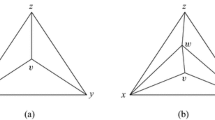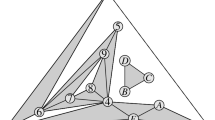Abstract
A spanning tree T in a graph G is a sub-graph of G with the same vertex set as G which is a tree. In 1981, McKay proved an asymptotic result regarding the number of spanning trees in random k-regular graphs. In this paper we prove a high-dimensional generalization of McKay’s result for random d-dimensional, k-regular simplicial complexes on n vertices, showing that the weighted number of simplicial spanning trees is of order \((\xi _{d,k}+o(1))^{\left( {\begin{array}{c}n\\ d\end{array}}\right) }\) as \(n\rightarrow \infty \), where \(\xi _{d,k}\) is an explicit constant, provided \(k> 4d^2+d+2\). A key ingredient in our proof is the local convergence of such random complexes to the d-dimensional, k-regular arboreal complex, which allows us to generalize McKay’s result regarding the Kesten–McKay distribution.


Similar content being viewed by others
References
Abu-Fraiha, A.: Homology of random simplicial complexes based on Steiner systems. Master thesis under the supervision of Roy Meshulam, pp. 1–74 (2016)
Anderson, G.W., Guionnet, A., Zeitouni, O.: An Introduction to Random Matrices. Cambridge Studies in Advanced Mathematics, vol. 118. Cambridge University Press, Cambridge (2010)
Bender, E.A., Canfield, E.R.: The asymptotic number of labeled graphs with given degree sequences. J. Combin. Theory Ser. A 24(3), 296–307 (1978)
Duval, A.M., Klivans, C.J., Martin, J.L.: Simplicial matrix-tree theorems. Trans. Am. Math. Soc. 361(11), 6073–6114 (2009)
Eckmann, B.: Harmonische Funktionen und Randwertaufgaben in einem Komplex. Comment. Math. Helv. 17, 240–255 (1945)
Friedman, J.: A proof of Alon’s second eigenvalue conjecture and related problems. Mem. Am. Math. Soc. 195(910), viii+100 (2008)
Gundert, A., Wagner, U.: On eigenvalues of random complexes. Isr. J. Math. 216(2), 545–582 (2016)
Hatcher, A.: Algebraic Topology. Cambridge University Press, Cambridge (2002)
Kalai, G.: Enumeration of Q-acyclic simplicial complexes. Isr. J. Math. 45(4), 337–351 (1983)
Keevash, P.: The existence of designs. arXiv preprint (2014). arXiv:1401.3665
Keevash, P.: Counting designs. J. Eur. Math. Soc. (JEMS) 20(4), 903–927 (2018)
Kesten, H.: Symmetric random walks on groups. Trans. Am. Math. Soc. 92, 336–354 (1959)
Linial, N., Peled, Y.: Enumeration and randomized constructions of hypertrees. Random Struct. Algorithms 55(3), 677–695 (2019)
Lubotzky, A., Luria, Z., Rosenthal, R.: Random Steiner systems and bounded degree coboundary expanders of every dimension. Discrete Comput. Geom. 62(4), 813–831 (2019)
Mason, J.C., Handscomb, D.C.: Chebyshev Polynomials. Chapman & Hall/CRC, Boca Raton (2003)
McKay, B.D.: Spanning trees in random regular graphs. In: Proceedings of the 3rd Caribbean Conference on Combinatorics and Computing (Bridgetown, 1981), pp. 139–143. Univ. West Indies, Barbados (1981)
McKay, B.D.: Spanning trees in regular graphs. Eur. J. Combin. 4(2), 149–160 (1983)
Parzanchevski, O., Rosenthal, R.: Simplicial complexes: spectrum, homology and random walks. Random Struct. Algorithms 50(2), 225–261 (2017)
Rosenthal, R.: Simplicial branching random walks. J. Appl. Comput. Topol. arXiv preprint (2014, to appear) arXiv:1412.5406
Tao, T.: 254A, Notes 3A Eigenvalues and Sums of Hermitian Matrices. Terence Tao-blog (2010). https://terrytao.wordpress.com/2010/01/12/254a-notes-3a-eigenvalues-and-sums-of-hermitian-matrices/
Tenenbaum, L.: Estimation of the weighted number of simplicial spanning trees of random \(k\)-regular simplicial complexes. Master thesis, pp. 1–62 (2020)
Wilf, H.S.: Generating Functionology, 3rd edn. A K Peters Ltd, Wellesley (2006)
Acknowledgements
The authors are grateful to Alex Lubotzky for fruitful discussions that led to this work. We would also like to thank Antti Knowles, Alan Lew, Zur Luria and Roy Meshulam for their insightful comments.
Author information
Authors and Affiliations
Corresponding author
Additional information
Publisher's Note
Springer Nature remains neutral with regard to jurisdictional claims in published maps and institutional affiliations.
Ron Rosenthal research partially supported by ISF grant 771/17 and BSF grant 2018330 and Lior Tenenbaum research partially supported by ISF grant 771/17.
Appendices
Appendices
Appendix A: Proof of Theorem 5.4
Let us start by stating a result of Friedmann regarding the spectral gap in the matching model.
Theorem A.1
([6]) Fix \(k\in \mathbb {N}\) and \(\varepsilon >0\). Then there exists a constant \(C_{k,\varepsilon }\in (0,\infty )\) such that a random graph G on n vertices sampled according to the matching model satisfies
where \(\lambda _1(G)\ge ...\ge \lambda _n(G)\) are the eigenvalues of A(G), the adjacency matrix of G, and \( \tau (k)= \lceil \sqrt{k-1} \rceil -1 \). Furthermore, there exists a constant \(C_k>0\), such that
where \(s(k)= \lfloor \sqrt{k-1} \rfloor \).
Let \(\epsilon >0\). As stated before in Theorem A.1, a random graph G on n vertices sampled according to the matching model satisfies (A.1). Recall that for every \(\sigma \in X_i^{d-2}\), the link of \(\sigma \), denoted \(\textrm{lk}(X_i,\sigma )\) is a random graph on \(n_i-d+1\) vertices, distributed according to the matching model with parameter k and therefore, the event
satisfies
A union bound, thus gives
where in the last bound we used the fact that \(|X^{d-2}_i|=\left( {\begin{array}{c}n_i\\ d-1\end{array}}\right) \).
By Garland’s method (cf. [7]), on the event \(\bigcup _{\sigma \in X^{d-2}_i} E_{i,\sigma ,\varepsilon }\), all non-trivial eigenvalues of the adjacency matrix of \(X_i\) are within \((-\infty ,2d\sqrt{k-1}+\varepsilon )\).
Hence, whenever \(\lceil \sqrt{k-1} \rceil >d+1\), by the Borel-Cantelli lemma, only finitely many of the random complexes \(X_i\) do not satisfy
Since \(\lceil \sqrt{k-1}\rceil >d+1\) whenever \(k>(d+1)^2+1\), the result follows.
Rights and permissions
Springer Nature or its licensor (e.g. a society or other partner) holds exclusive rights to this article under a publishing agreement with the author(s) or other rightsholder(s); author self-archiving of the accepted manuscript version of this article is solely governed by the terms of such publishing agreement and applicable law.
About this article
Cite this article
Rosenthal, R., Tenenbaum, L. Simplicial Spanning Trees in Random Steiner Complexes. Combinatorica 43, 613–650 (2023). https://doi.org/10.1007/s00493-023-00038-3
Received:
Revised:
Accepted:
Published:
Issue Date:
DOI: https://doi.org/10.1007/s00493-023-00038-3
Keywords
- Random Steiner systems
- Random simplicial complexes
- Simplicial spanning trees
- Kesten-McKay distribution
- Benjamini-Schramm convergence




